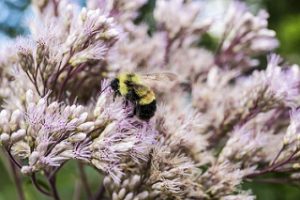Fayette Aurelia Nichols gave an information-packed presentation to us on May 20 based on her extensive research and experience with this bumblebee. Not only did we learn some basics about bumblebees in general, but Aurelia gave us some very specific information to help the Rusty-patched Bumblebee. The Rusty-patched Bumblebee was a very abundant species at one point in the Chicago area, but recently, over the past 20 years, scientists have started to record significant drops in the almost all bumblebee populations. For the Rusty-patched Bumblebee, that drop is 87%. 1/3 of all other bumblebees are also at risk of extinction. The reasons are many and familiar: habitat loss, degradation (habitat may be infiltrated by invasive species), pesticide use, and introduced diseases from commercial honeybees and bumblebees (raised in domestic conditions and purchased for crop pollination).
Why we should care:
They–
- Evolved 30 million years ago and have done well until recent years
- Are cognitive animals: they can plan and problem-solve. Aurelia shared a video demonstrating experiments that demonstrated these thinking skills. They have capacity for memories as well.
- Use tools
- Have a collective culture
- Improve upon learned behavior
- Pass knowledge down to the next generation; Queens that overwintered teach skills to the their young, and the cycle continues between each year’s generation of bumblebees
- Are important pollinators–can pollinate longer and in cooler conditions than any other bee. They can visit 2-4x more flowers per minute than other bees.
Identification tips:
- Distinctive black tuft on head
- RPB has a shorter, broader face than other bumblebees
- Face all black
- Short antennae relative to other bumblebees
- Their hair is dense and of even length. Coat often described as “looks like a mink;other bumblebees look like a raccoon.”
- Female workers and males have the rusty patch in the middle of the 2 yellow segments on the abdomen
- Queen is larger and generally has no rusty patch (though there are some individuals that might)–just 2 yellow segments
- Amber wings
- Diamond black spot on thorax (between the wings)
What we can do:
- Avoid pesticides and planting plants that have been treated with pesticides, particularly neonicotinoids.
- Avoid fungicides which also harm bees
- Plant native spring ephemerals–provide essential pollen and nectar in the spring when little is available. Dutchman’s Breeches and Trout Lilies are vital to them.
- Native plants offer more nutritious pollen
- Allow nesting sites; they might use ground nesting mammals’ holes (chipmunks, rabbits, field mice) and places under sedges, grasses. Queens will search for 2 weeks in the spring for an appropriate nesting site. If you find one, please report to Bumblebeewatch.org
- Condensed plantings important–increased density of floral resources and cover
- Native shrub hedgerows provide mating circuits and foraging niches (hedgerows also help butterflies avoid predation)
- Creating an “understory” of sedges offers them cool refuge during the high heat of summer; sedges also help to keep weeds to a minimum by reducing open ground.
- Provide a continuous succession of bloom from mid-March-to October. Have 10 different species of native plants blooming at the same time all season (admittedly a tall order but an ideal we can strive for and not impossible when you factor in flowering trees and shrubs).
- Penstemon, Prairie Clovers, Hyssops, Monarda (and other “super-foods”) are important for a healthy colony
- Turtlehead and native sunflowers support their immune systems
- Asters and goldenrods critical for their ability to survive winter
This recap provides a lot of information but is not exhaustive of all that Aurelia had to share with us. Her presentation is a must-see if this topic is of interest to you.
More information:
USFWS Pocket Guide (identification and other info)
Xerces Society Identification Guide
Bumblebee Watch: Submit sightings here & nest sites
Bee Spotter: Submit sightings here
Heather Holm’s Bumblebee Banquet List
(Featured image at the top of the page is by Joan Sayre)

